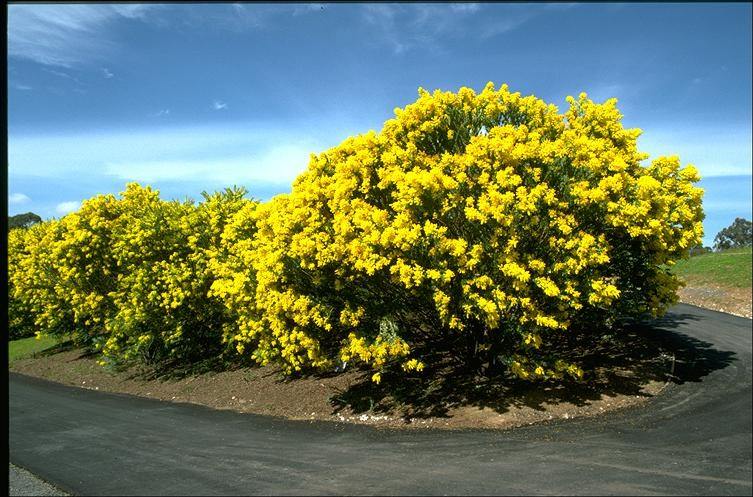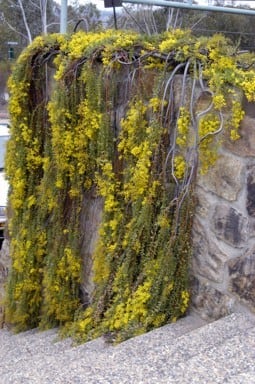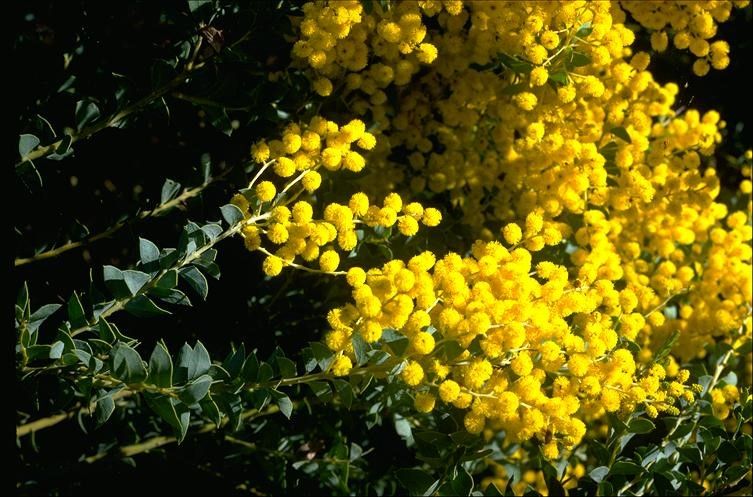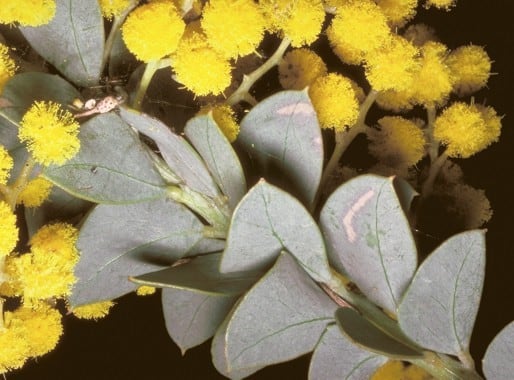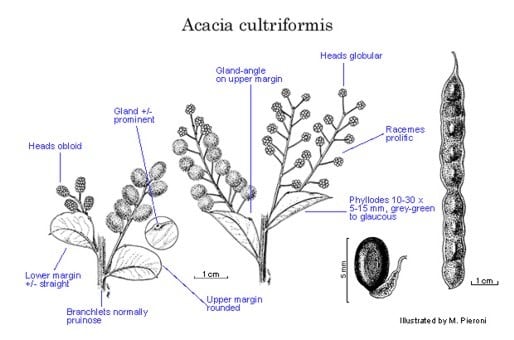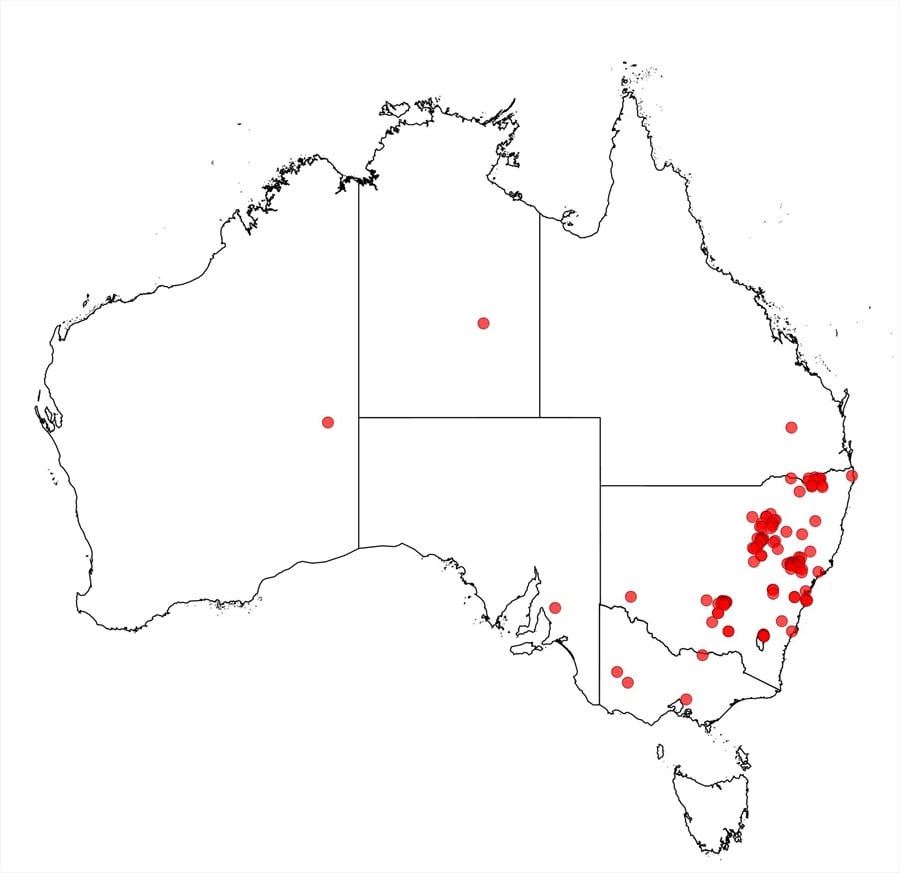Acacia cultriformis A.Cunn. ex G.Don
WATTLE
Acacias of Australia
Common Name
Knife-leaf Wattle, Dog-tooth Wattle, Half-moon Wattle, Golden Glow Wattle
Family
Fabaceae
Distribution
Discontinuous from Narrandera, N.S.W., N to the Stanthorpe-Inglewood area, south-eastern Qld. It is incipiently naturalized in parts of Vic.
Description
Shrub to c. 4 m high. Branchlets normally lightly to conspicuously pruinose, glabrous. Phyllodes rather crowded, inequilateral, often ±triangular, broadest about the middle, with abaxial margin ±straight and adaxial margin markedly rounded or angled, 10–30 mm long, 5–15 mm wide, coriaceous, grey-green to glaucous, light green when young, glabrous; midrib central or excentric; lateral nerves not prominent; gland rather prominent, at or slightly below widest part of phyllode. Racemes prolific in upper axils; axes 1–5 cm long, sometimes to 20 cm, glabrous; peduncles 2.5–5 mm long, glabrous; heads globular to shortly cylindrical, 13–40-flowered, bright golden. Flowers 5-merous; sepals united. Pods narrowly oblong, raised over seeds, to 9 cm long, (4–) 5–8 mm wide, firmly chartaceous, often pruinose, glabrous. Seeds longitudinal, oblong, 3.5–4.5 mm long, dull to slightly shiny, black; aril ±clavate.
Habitat
Grows in sand or clayey loam in Eucalyptus communities.
Specimens
Qld: Bracker Ck, Stanthorpe–Inglewood road, W.J.F.McDonald 1176 (BRI). N.S.W.: 15 km by road W of West Wyalong, E.F.Constable 7273 (NSW, PERTH); about 2.5 km SE of Brogedah HS on road to Muswellbrook, B.R.Maslin 5924 (NSW, PERTH); 10 km from Jerrys Plain towards Denman, N.Hall H78/7 (NSW, PERTH); Hunter R. [area], A.Cunningham 103/1825 (BM, K, NY), 104/1825 (BM) and 87/1827 (A, BM, K); Vic.: Melbourne suburb of Heatmont, on N side of railway line opposite S end of Daniella Cres., J.C.Reid 2694 (MEL n.v., PERTH).
Notes
Seemingly related to A. semilunata which is distinguished especially by its branchlets normally hairy to some degree, phyllodes never angled along their adaxial margin, glands less prominent, heads always globular and narrower pods (4–5 mm wide). Acacia pravissima sometimes superficially resembles A. cultriformis.
Widely cultivated; the cultivar A. cultriformis ‘Cascade’ has a loose, pendulous growth habit, reaches 0.3 m high and spreads to 2–4 m, fide W.R.Elliot & D.L.Jones, Encycl. Austral. Pl. 2: 37 (1982) and M.Hitchcock, Austral. Pl. 22: 324–325 (2004).
L.Pedley, Austrobaileya 1: 278 (1980), suggested that A. cultriformis and A. scapuliformis might best be treated as distinct subspecies. Specimens agreeing with the type of A. cultriformis are confined mainly to the Hunter R. area, N.S.W., and are characterised by ±globular, 13–20-flowered heads, and phyllodes 14–30 mm long and 5–8 mm wide with l:w = 3–4. The type of A. scapuliformis is encompassed by the more widespread entity which has obloid to shortly cylindrical, 30–40-flowered heads, and phyllodes 10–30 mm long and 6–15 mm wide with l:w = 1.5–2.5.
FOA Reference
Data derived from Flora of Australia Volumes 11A (2001), 11B (2001) and 12 (1998), products of ABRS, ©Commonwealth of Australia
Author
Minor edits by B.R.Maslin & J.Rogers
B.R.Maslin
This identification key and fact sheets are available as a mobile application:
URL: https://apps.lucidcentral.org/wattle/
© Copyright 2018. All rights reserved.

